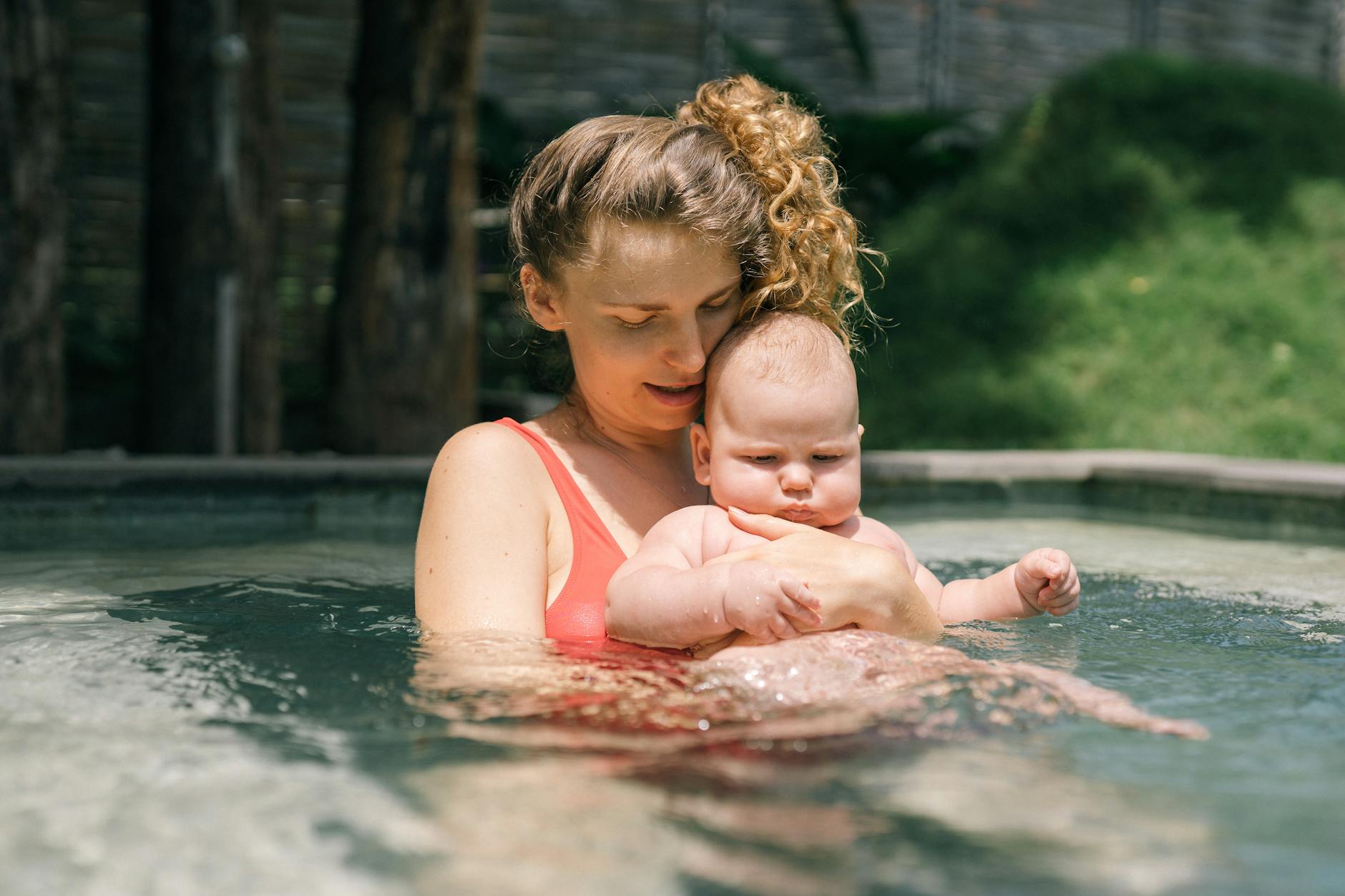Teaching infants to swim is not only a valuable life skill but also a great way to introduce them to the water in a safe and enjoyable manner.
Swimming offers numerous benefits to infants, including physical development, water safety awareness, and cognitive stimulation.
By starting early, you can help your child develop a lifelong love for swimming while ensuring their safety around water.
The Importance of Teaching Infants to Swim
Teaching infants to swim is not only a valuable life skill but also a great way to introduce them to the water in a safe and enjoyable manner.
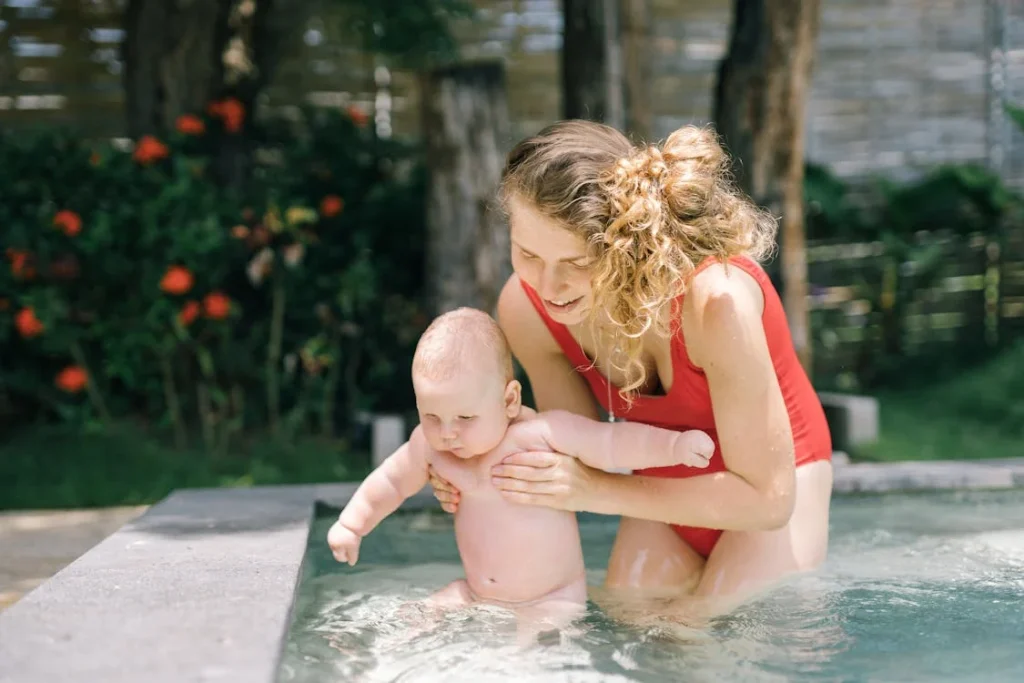
Swimming offers numerous benefits to infants, including physical development, water safety awareness, and cognitive stimulation.
By starting early, you can help your child develop a lifelong love for swimming while ensuring their safety around water.
Infant swimming lessons provide an opportunity for babies as young as six months old to become comfortable in an aquatic environment.
These lessons are designed to promote water confidence, proper breath control, and basic swimming skills.
By teaching infants to swim, you are equipping them with essential life-saving abilities and empowering them to enjoy water activities throughout their lives.
Age-appropriate Techniques for Teaching Infants to Swim
Teaching infants to swim requires age-appropriate techniques that focus on building their confidence and ensuring their safety.
For babies between six and twelve months old, a gentle introduction to water is crucial:
-
Start with simple activities like pouring warm water over their bodies or gently splashing their feet.
-
Gradually progress to holding them securely in the water, allowing them to float on their backs, and encouraging them to kick their legs.
As infants grow older, around twelve to eighteen months, you can introduce more advanced techniques such as arm movements and basic water propulsion.
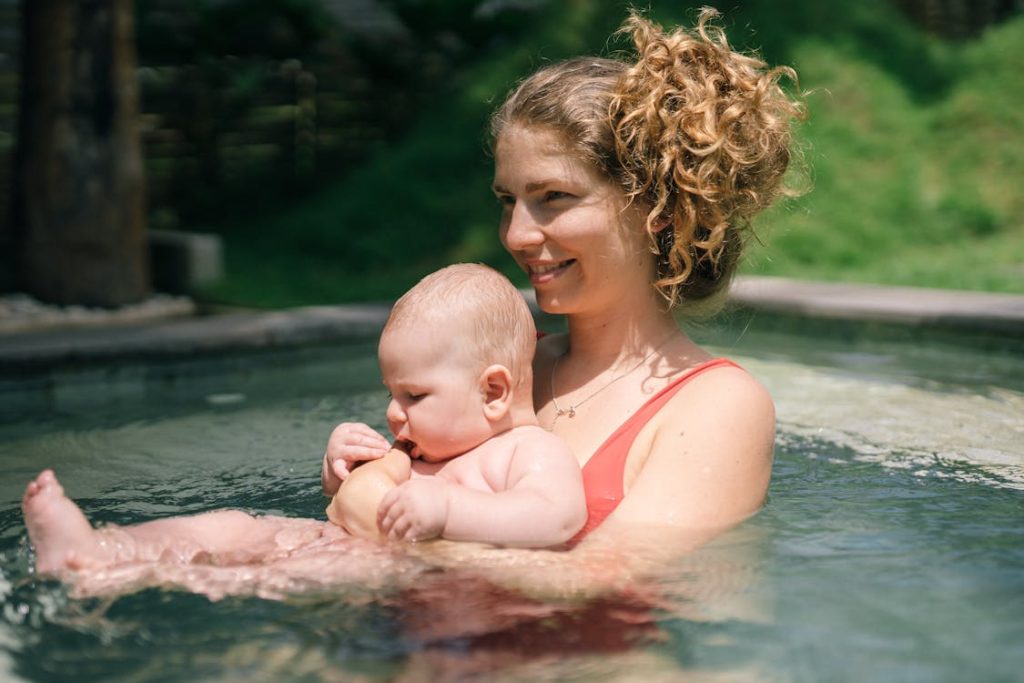
Use flotation devices like arm bands or swim vests to provide additional support and stability during these activities.
Remember to always supervise your child closely and never leave them unattended in the water, regardless of their swimming abilities.
READ ALSO: How to Support Young Swimmers to Reach Their Full Potential
Safety Precautions for Teaching Infants to Swim
Ensuring the safety of infants during swimming lessons is of utmost importance. Follow these safety precautions to create a secure environment for your child:
- Constant supervision: Never leave your child unattended in the water, even for a few seconds. Always stay within arm’s reach.
- Secure environment: Make sure the swimming area is fenced and childproofed to prevent accidents. Remove any potential hazards, such as toys or sharp objects.
- Proper flotation devices: Use age-appropriate flotation devices to provide support and stability. Ensure they fit properly and do not restrict your child’s movements.
- Warm water temperature: Maintain a comfortable water temperature between 85°F and 90°F (29°C and 32°C) to keep your child relaxed and prevent hypothermia.
- Gradual progression: Gradually introduce new techniques and activities, allowing your child to feel comfortable and confident at each stage.
By following these safety precautions, you can minimize the risks associated with teaching infants to swim and create a safe and enjoyable learning experience.
How to Create a Positive and Comfortable Environment for Teaching Infants to Swim
Creating a positive and comfortable environment is essential for successful infant swimming lessons.
Here are some tips to ensure a positive experience for both you and your child:
- Establish trust: Build a strong bond with your child by spending time in the water together before formal lessons. Let them associate water with fun and security.
- Maintain a calm demeanor: Babies are highly perceptive and can sense if you are anxious or stressed. Stay calm and composed to create a relaxed atmosphere.
- Use positive reinforcement: Praise and encourage your child’s progress, even for small achievements. Positive reinforcement boosts their confidence and motivation.
- Keep it fun: Incorporate games, songs, and toys into your swimming sessions. Make it an enjoyable experience that your child looks forward to.
- Be patient: Each child learns at their own pace. Avoid rushing or pressuring them. Patience is key to creating a positive environment for learning.
By creating a positive and comfortable environment, you can help your child develop a love for swimming and ensure their enthusiasm for future lessons.
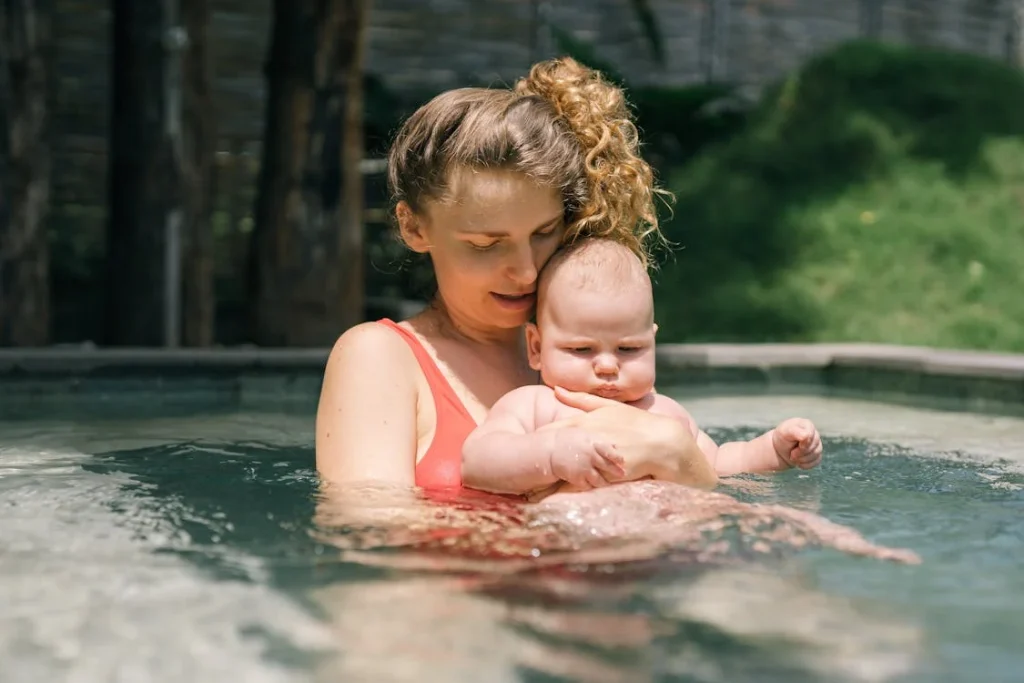
Introducing Infants to Water and Building Their Confidence
Introducing infants to water at an early age is crucial for building their confidence and comfort in aquatic environments.
Follow these steps to ease your child into the water:
- Start with familiar surroundings: Begin by introducing your child to water in a familiar environment, such as a bathtub. Let them explore the sensation of water on their skin.
- Gradual immersion: Slowly immerse your child in a shallow pool or bathtub, supporting them securely. Allow them to get accustomed to the feeling of buoyancy and the water around them.
- Play and engage: Make water playtime enjoyable by using bath toys or pouring water gently over their bodies. Sing songs or engage in interactive activities to create a positive association with water.
- Encourage kicking and splashing: As your child grows more comfortable, encourage them to kick their legs and splash the water. This helps develop their motor skills and builds confidence.
- Progress to deeper water: Once your child feels secure in shallow water, gradually move to deeper areas. Always provide support and reassurance during this transition.
By gradually introducing your child to water and building their confidence, you are laying a strong foundation for their future swimming abilities.
READ ALSO: Why Are Some Swimmers Faster Than Others?
Teaching Basic Swimming Skills to Infants
Teaching basic swimming skills to infants involves a series of progressive activities that focus on water adaptation and developing fundamental techniques.
Here are some essential skills to teach your child:
- Breath control: Teach your child how to hold their breath while their face is submerged in the water. Practice blowing bubbles and gradually extend the duration.
- Back floating: Assist your child in floating on their back, providing support under their head and back. This position helps develop a sense of buoyancy and relaxation.
- Kicking and leg movements: Encourage your child to kick their legs in the water, propelling themselves forward. Assist their movements until they gain sufficient strength and coordination.
- Arm movements: Teach your child basic arm movements, such as reaching and grabbing. These actions prepare them for more advanced swimming strokes in the future.
- Water safety awareness: Educate your child about water safety rules, such as not entering the water without adult supervision and knowing how to call for help.
By focusing on these basic swimming skills, you are laying a strong foundation for your child’s future swimming abilities and water safety awareness.
Teaching Infant Rescue Swimming Techniques
Teaching infants rescue swimming techniques is a vital aspect of their swimming education.
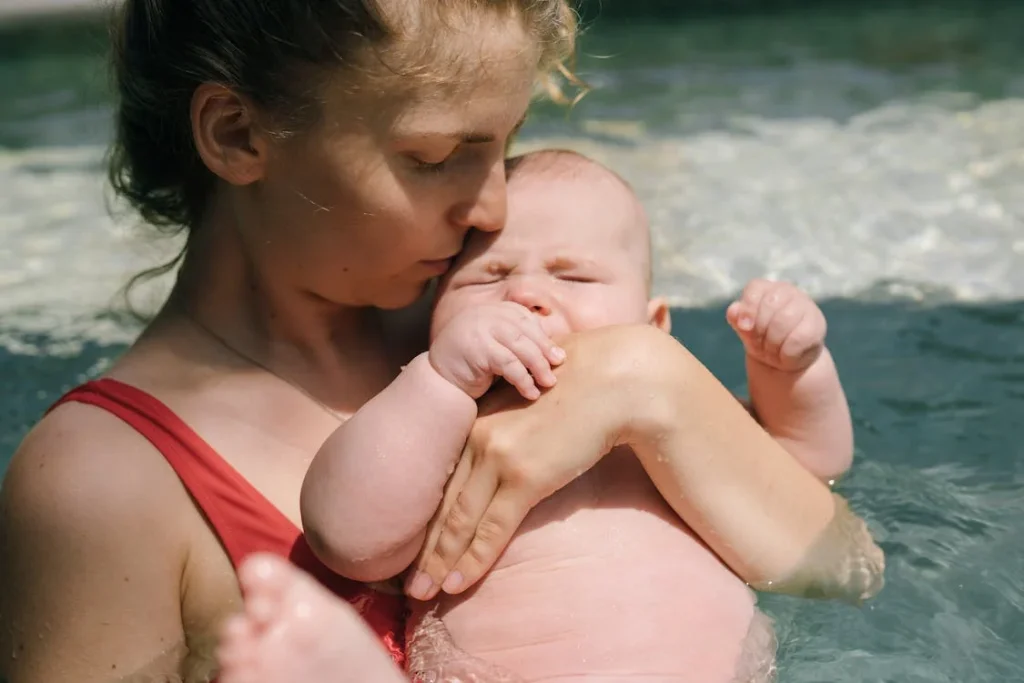
While no child is drown-proof, teaching them these skills can increase their chances of survival in case of an emergency.
Here are some essential infant rescue swimming techniques to teach:
- Rolling onto their back: Teach your child to roll onto their back and float if they accidentally fall into the water. Practice this skill regularly to reinforce muscle memory.
- Reaching and grabbing: Teach your child to reach for and grab onto objects, such as the edge of a pool or a flotation device, if they are unable to reach the side.
- Calling for help: Instill in your child the importance of calling for help when they are in distress. Teach them to scream for assistance or use a whistle if available.
- Exit strategies: Show your child how to safely exit the water, whether it be from a pool, lake, or other bodies of water. Practice climbing out of the water using stairs or a ladder.
While teaching infant rescue swimming techniques, always remember that the primary focus should be on preventing accidents and constant supervision.
Tips for Teaching 2-Years-Old to Swim
Teaching 2-years-old to swim requires a slightly different approach due to their increased motor skills and cognitive abilities.
Here are some tips to help you teach 2-years-old to swim:
- Keep lessons short and engaging: Due to their limited attention span, keep swimming lessons for 2-years-old short and focused. Plan activities that are interactive and engaging to hold their interest.
- Use visual aids: Incorporate visual aids such as colorful toys, pool noodles, or floating objects to make the learning process more enjoyable and interactive.
- Encourage independent movements: As 2-years-old become more independent, encourage them to practice swimming movements on their own. Offer support and guidance as needed.
- Practice water safety skills: Reinforce water safety skills by teaching your child to hold onto the wall, climb out of the pool, and call for help if needed. Regularly review these skills to ensure they become second nature.
- Celebrate milestones: Celebrate your child’s achievements and milestones in their swimming journey. This positive reinforcement will motivate them to continue learning and improving.
Remember that each child develops at their own pace. Be patient and supportive, and make swimming lessons a fun and positive experience for your 2-year-old.
Resources and Courses for Learning How to Teach Infants to Swim
If you’re interested in learning more about how to teach infants to swim, there are several resources and courses available to guide you through the process.
Here are some recommended options:
- Parent and child swimming classes: Many local community centers, swim schools, and recreational facilities offer parent and child swimming classes. These classes provide hands-on guidance and support from experienced instructors.
- Online tutorials and videos: Explore online platforms that offer tutorials and videos specifically focused on teaching infants to swim. These resources often provide step-by-step instructions and demonstrations.
- Books and eBooks: Look for books and eBooks written by experts in infant swimming instruction. These resources offer in-depth knowledge, techniques, and tips for teaching infants to swim.
- Certification programs: Consider enrolling in a certification program for infant swimming instruction. These programs provide comprehensive training on teaching techniques, safety protocols, and child development.
By utilizing these resources and courses, you can enhance your knowledge and skills in teaching infants to swim, ensuring a safe and effective learning experience.
READ ALSO: 14 Important Swim Meet Survival Kit
Conclusion
Teaching infants to swim is an invaluable investment in their safety, development, and lifelong enjoyment of water activities.
By following age-appropriate techniques, implementing safety precautions, and creating a positive environment, you can help your child become confident and skilled swimmers from an early age.
Remember to always prioritize their safety, provide constant supervision, and celebrate their progress along the way.
If you want to read more about teaching various sports skills to children, subscribe to our newsletter.
Stay up-to-date with the latest tips, techniques, and answers to difficult sports questions. Join our community of sports enthusiasts and empower your child’s athletic journey.
Remember, teaching infants to swim is a rewarding experience that not only imparts essential skills but also creates lasting memories of joy and adventure in the water.
Start early, be patient, and enjoy the incredible journey of teaching your infant to swim.
